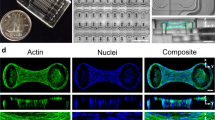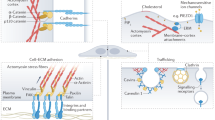Abstract
The mechanical stability and integrity of biological cells is provided by the cytoskeleton, a semidilute meshwork of biopolymers. Recent research has underscored its role as a dynamic, multifunctional muscle, whose passive and active mechanical performance is highly heterogeneous in space and time and intimately linked to many biological functions, such that it may serve as a sensitive indicator for the health or developmental state of the cell. In vitro reconstitution of ‘functional modules’ of the cytoskeleton is now seen as a way of balancing the mutually conflicting demands for simplicity, which is required for systematic and quantitative studies, and for a sufficient degree of complexity that allows a faithful representation of biological functions. This bottom-up strategy, aimed at unravelling biological complexity from its physical basis, builds on the latest advances in technology, experimental design and theoretical modelling, which are reviewed in this progress report.
This is a preview of subscription content, access via your institution
Access options
Subscribe to this journal
Receive 12 print issues and online access
$209.00 per year
only $17.42 per issue
Buy this article
- Purchase on Springer Link
- Instant access to full article PDF
Prices may be subject to local taxes which are calculated during checkout


Similar content being viewed by others
References
Gardel, M. L. et al. Prestressed F-actin networks cross-linked by hinged filamins replicate mechanical prperties of cells. Proc. Natl Acad. Sci. USA 103, 1762–1767 (2006).
Fabry, B. et al. Scaling the microrheology of living cells. Phys. Rev. Lett. 87, 148102 (2001).
Fernandez, P., Pullarkat, P. A. & Ott, A. A master relation defines the nonlinear viscoelasticity of single fibroblasts. Biophys. J.doi:10.1529/biophysj.105.072215 (2006).
Guck, J. et al. Optical deformability as an inherent cell marker for testing malignant transformation and metastatic competence. Biophys. J. 88, 3689–3698 (2005).
Svitkina, T. M. et al. Mechanism of filopodia initiation by reorganization of a dendritic network. J. Cell Biol. 160, 409–421 (2003).
Small, J. V., Stradal, T., Vignal, E. & Rottner, K. The lamellipodium: where motilitiy begins. Trends Cell Biol. 12, 112–120 (2002).
Bausch, A. R., Ziemann, F., Boulbitch, A. A., Jacobson, K. & Sackmann, E. Local measurements of viscoelastic parameters of adherent cell surfaces by magnetic bead microrheometry. Biophys. J. 75, 2038–2049 (1998).
Radmacher, M. in Atomic Force Microscopy in Cell Biology (eds Jena, B. P., Horber, J. K. H. & Matsudaira, P. T.) 67–90 (Academic, London, 2002).
Mahaffy, R. E., Shih, C. K., MacKintosh, F. C. & Kas, J. Scanning probe-based frequency-dependent microrheology of polymer gels and biological cells. Phys. Rev. Lett. 85, 880–883 (2000).
Hartwell, L. H., Hopfield, J. J., Leibler, S. & Murray, A. W. From molecular to modular cell biology. Nature 402, 47–51 (1999).
Mogliner, A. & Rubinstein, B. The physics of vilopodial protrusion. Biophys. J. 89, 782–795 (2005).
Alberts, J. B. & Odell, G. M. In silico reconstitution of listeria propulsion exhibits nano-saltation. PLOS Biol. 2, 2054–2066 (2004).
de Gennes, P. G. Scaling Concepts in Polymer Physics (Cornell Univ. Press, Ithaca and London, 1979).
Morse, D. C. Viscoelasticity of concentrated isotropic solutions of semiflexible polymers. 2. Linear response. Macromolecules 31, 7044–7067 (1998).
Isambert, H. & Maggs, A. C. Dynamics and rheology of actin solutions. Macromolecules 29, 1036–1040 (1996).
Hinner, B., Tempel, M., Sackmann, E., Kroy, K. & Frey, E. Entanglement, elasticity, and viscous relaxation of actin solutions. Phys. Rev. Lett. 81, 2614–2617 (1998).
Gardel, M. L., Valentine, M. T., Crocker, J. C., Bausch, A. R. & Weitz, D. A. Microrheology of entangled F-actin solutions. Phys. Rev. Lett. 91, 158302 (2003).
Mackintosh, F. C., Kas, J. & Janmey, P. A. Elasticity of semiflexible biopolymer networks. Phys. Rev. Lett. 75, 4425–4428 (1995).
Shin, J. H., Gardel, M. L., Mahadevan, L., Matsudaira, P. & Weitz, D. A. Relating microstructure to rheology of a bundled and cross-linked F-actin network in vitro. Proc. Natl Acad. Sci. USA 101, 9636–9641 (2004).
Wilhelm, J. & Frey, E. Elasticity of stiff polymer networks. Phys. Rev. Lett. 91, 108103 (2003).
Head, D. A., Levine, A. J. & MacKintosh, E. C. Deformation of cross-linked semiflexible polymer networks. Phys. Rev. Lett. 91, 108102 (2003).
Head, D. A., Levine, A. J. & MacKintosh, F. C. Distinct regimes of elastic response and deformation modes of cross-linked cytoskeletal and semiflexible polymer networks. Phys. Rev. E 68, 061907 (2003).
Heussinger, C. & Frey, E. Stiff polymers, foams and fiber networks. Phys. Rev. Lett. 96, 017802 (2006).
Onck, P. R., Koeman, T., van Dillen, T. & van der Giessen, E. The origin of stiffening in cross-linked semiflexible networks. Phys. Rev. Lett. 95, 178102 (2005).
Gardel, M. L. et al. Elastic behavior of cross-linked and bundled actin networks. Science 304, 1301–1305 (2004).
Storm, C., Pastore, J. J., MacKintosh, F. C., Lubensky, T. C. & Janmey, P. A. Nonlinear elasticity in biological gels. Nature 435, 191–194 (2005).
Kruse, K., Joanny, J. F., Jülicher, F., Prost, J. & Sekimoto, K. Generic theory of active polar gels: a paradigm for cytoskeletal dynamics. Eur. Phys. J. E 16, 5–16 (2005).
Ziebert, F. & Zimmermann, W. Nonlinear competition between asters and stripes in filament-motor systems. Eur. Phys. J. E 18, 41–54 (2005).
Liverpool, T. B. & Marchetti, M. C. Bridging the microscopic and the hydrodynamic in active filament solutions. Europhys. Lett. 69, 846–852 (2005).
Toner, J., Tu, Y. & Ramaswamy, S. Hydrodynamics and phases of flocks. Ann. of Phys. 318, 170–244 (2005).
Jingyuan, X. et al. Mechanical properties of actin filament networks depend on preparation, polymerization conditions, and storage of actin monomers. Biophys. J. 74, 2731–2740 (1998).
Le Goff, L., Hallatschek, O., Frey, E. & Amblard, F. Tracer studies on F-actin fluctuations. Phys. Rev. Lett. 89, 258101 (2002).
Charras, G. T., Yarrow, Y. C., Horton, M. A., Mahadevan, L. & Mitchison, T. J. Non-equilibration of hydrostatic pressure in blebbing cells. Nature 435, 365–369 (2005).
Gittes, F., Schnurr, B., Olmsted, P. D., MacKintosh, F. C. & Schmidt, C. F. Microscopic viscoelasticity: Shear moduli of soft materials determined from thermal fluctuations. Phys. Rev. Lett. 79, 3286–3289 (1997).
Gittes, F. & MacKintosh, F. C. Dynamic shear modulus of a semiflexible polymer network. Phys. Rev. E 58, R1241–R1244 (1998).
Gittes, F., Mickey, B., Nettleton, J. & Howard, J. Flexural rigidity of microtubules and actin filaments measured from thermal fluctuations in shape. J. Cell. Biol. 120, 923–934 (1993).
Morse, D. C. Viscoelasticity of tightly entangled solutions of semiflexible polymers. Phys. Rev. E 58, R1237–R1240 (1998).
Mohrdieck, C. et al. A theoretical description of elastic pillar substrates in biophysical experiments. ChemPhysChem 6, 1492–1498 (2005).
Liu, J. et al. Microrheology probes length scale dependent rheology. Phys. Rev. Lett. (in the press).
Levine, A. J. & Lubensky, T. C. One- and two-particle microrheology. Phys. Rev. Lett. 85, 1774–1777 (2000).
Tseng, Y., Schafer, B. W., Almo, S. C. & Wirtz, D. Functional synergy of actin filament cross-linking proteins. J. Biol. Chem. 277, 25609–25616 (2002).
Hosek, M. & Tang, J. X. Polymer-induced bundling of F actin and the depletion force. Phys. Rev. E 69, 051907 (2004).
Tharmann, R., Claessens, M. M. A. E. & Bausch, A. R. Micro- and macrorheological properties of actin networks effectively crosslinked by depletion forces. Biophys. J. 90, 2622–2627 (2006).
Borukhov, L., Bruinsma, R. F., Gelbart, W. M. & Liu, A. J. Structural polymorphism of the cytoskeleton: A model of linker-assisted filament aggregation. Proc. Natl Acad. Sci. USA 102, 3673–3678 (2005).
Tempel, M., Isenberg, G. & Sackmann, E. Temperature-induced sol-gel transition and microgel formation in alpha-actinin cross-linked actin networks: A rheological study. Phys. Rev. E 54, 1802–1810 (1996).
Tseng, Y., Fedorov, E., McCaffery, J. M., Almo, S. C. & Wirtz, D. Micromechanics and ultrastructure of actin filament networks crosslinked by human fascin: A comparison with alpha-actinin. J. Mol. Biol. 310, 351–366 (2001).
Kierfeld, J., Kuhne, T. & Lipowsky, R. Discontinuous unbinding transitions of filament bundles. Phys. Rev. Lett. 95, 038102 (2005).
Valentine, M. T. et al. Colloid surface chemistry critically affects multiple particle tracking measurements of biomaterials. Biophys. J. 86, 4004–4014 (2004).
Shin, J. H., Mahadevan, L., So, P. T. & Matsudaira, P. Bending stiffness of a crystalline actin bundle. J. Mol. Biol. 337, 255–261 (2004).
Howard, J. & Ashmore, J. F. Stiffness of sensory hair bundles in the acculus of the frog. Hear. Res. 23, 93–104 (1986).
Limozin, L. & Sackmann, E. Polymorphism of cross-linked actin networks in giant vesicles. Phys. Rev. Lett. 89, 168103 (2002).
Claessens, M. M. A. E., Tharmann, R., Kroy, K. & Bausch, A. R. Microstructure and viscoelasticity of confined semiflexible polymer networks. Nature Phys. 2, 186–189 (2006).
Humphrey, D., Duggan, C., Saha, D., Smith, D. & Kas, J. Active fluidization of polymer networks through molecular motors. Nature 416, 413–416 (2002).
Le Goff, L., Amblard, F. & Furst, E. M. Motor-driven dynamics in actin-myosin networks. Phys. Rev. Lett. 88, 018101 (2002).
Nedelec, F. J., Surrey, T., Maggs, A. C. & Leibler, S. Self-organization of microtubules and motors. Nature 389, 305–308 (1997).
Lau, A. W. C., Hoffman, B. D., Davies, A., Crocker, J. C. & Lubensky, T. C. Microrheology, stress fluctuations, and active behavior of living cells. Phys. Rev. Lett. 91, 198101 (2003).
Pantaloni, D., Le Clainche, C. & Carlier, M. F. Mechanism of actin-based motility. Science 292, 1502–1506 (2001).
Marcy, Y., Prost, J., Carlier, M. F. & Sykes, C. Forces generated during actin-based propulsion: A direct measurement by micromanipulation. Proc. Natl Acad. Sci. USA 101, 5992–5997 (2004).
Vignjevic, D. et al. Mechanism for formation of filopodial-like bundles in vitro. Mol. Biol. Cell 13, 177A–177A (2002).
Amblard, F., Yurke, B., Pargellis, A. & Leibler, S. A magnetic manipulator for studying local rheology and micromechanical properties of biological systems. Rev. Sci. Inst. 67, 818–827 (1996).
Ziemann, F., Radler, J. & Sackmann, E. Local measurements of viscoelastic moduli of entangled actin networks using an oscillating magnetic bead micro-rheometer. Biophys. J. 66, 2210–2216 (1994).
Schmidt, F. G., Ziemann, F. & Sackmann, E. Shear field mapping in actin networks by using magnetic tweezers. Eur. Biophys. J. 24, 348–353 (1996).
Crocker, J. C. et al. Two-point microrheology of inhomogeneous soft materials. Phys. Rev. Lett. 85, 888–891 (2000).
Mason, T. G. & Weitz, D. A. Optical measurements of frequency-dependent linear viscoelastic moduli of complex fluids. Phys. Rev. Lett. 74, 1250–1253 (1995).
Schmidt, F. G., Hinner, B. & Sackmann, E. Microrheometry underestimates the values of the viscoelastic moduli in measurements on F-actin solutions compared to macrorheometry. Phys. Rev. E 61, 5646–5653 (2000).
Acknowledgements
We thank T. M. Svitkina for providing Fig. 1. We also thank Oliver Lieleg and Rainer Tharmann for providing figures and schematics. The work of ARB is supported by SFB413, also the support of the “Fonds der Chemischen Industrie” is gratefully acknowledged.
Author information
Authors and Affiliations
Corresponding authors
Ethics declarations
Competing interests
The authors declare no competing financial interests.
Rights and permissions
About this article
Cite this article
Bausch, A., Kroy, K. A bottom-up approach to cell mechanics. Nature Phys 2, 231–238 (2006). https://doi.org/10.1038/nphys260
Received:
Accepted:
Issue Date:
DOI: https://doi.org/10.1038/nphys260
This article is cited by
-
Monitoring the mass, eigenfrequency, and quality factor of mammalian cells
Nature Communications (2024)
-
Scaling behaviour and control of nuclear wrinkling
Nature Physics (2023)
-
3D printed protein-based robotic structures actuated by molecular motor assemblies
Nature Materials (2022)
-
Rheology of rounded mammalian cells over continuous high-frequencies
Nature Communications (2021)
-
Magnetically-driven 2D cells organization on superparamagnetic micromagnets fabricated by laser direct writing
Scientific Reports (2020)



